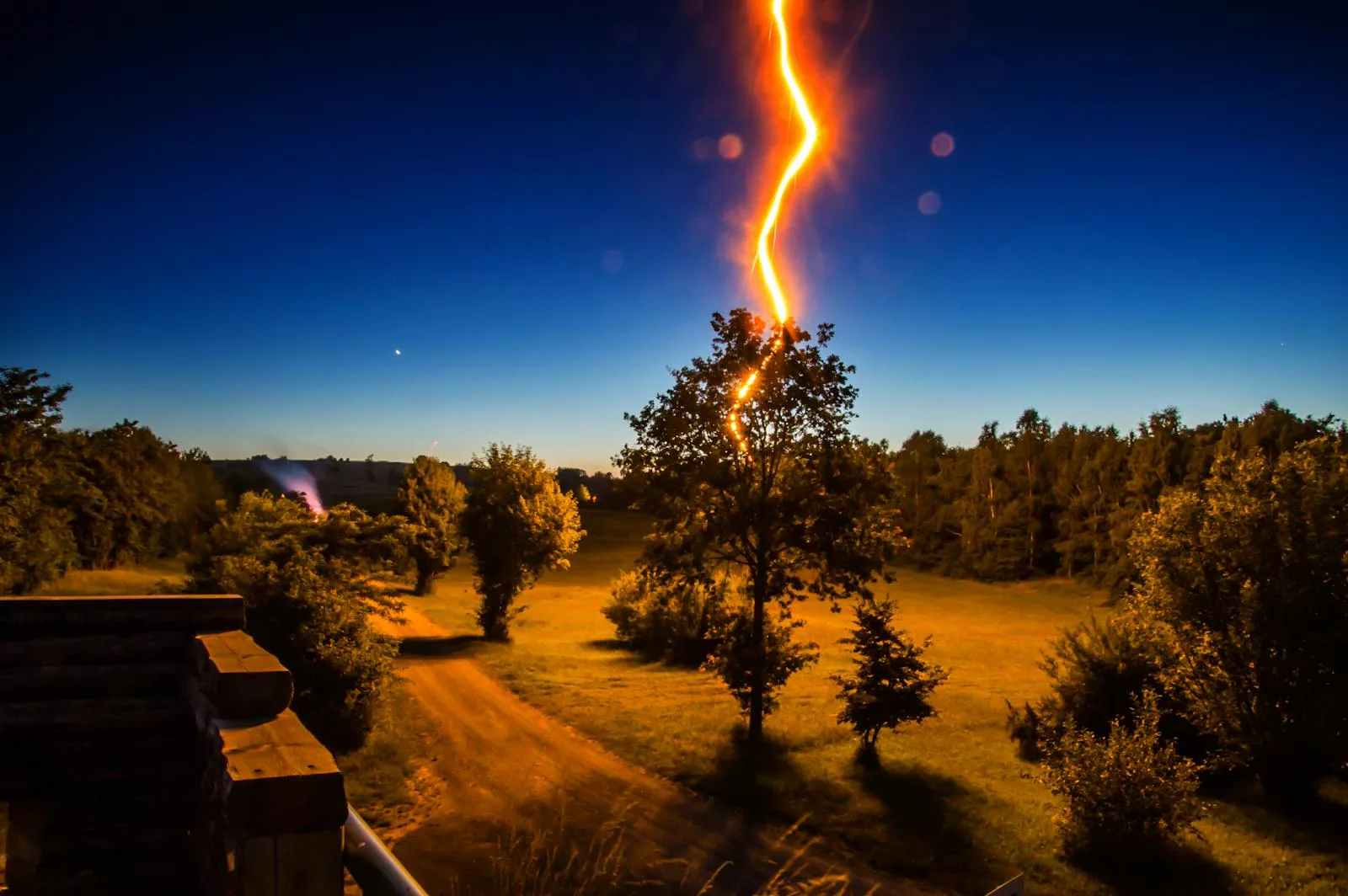Earthquakes are among nature’s most powerful and unpredictable phenomena, but their mystery deepens when strange flashes of light are reported in the moments before or during a quake. Known as earthquake lightning or earthquake lights (EQL), these luminous displays have puzzled scientists and witnesses for centuries. Described as glowing orbs, flickering lights, or brief flashes, earthquake lightning often occurs near fault lines, adding another layer of intrigue to seismic activity. In this article, we explore the science behind this fascinating phenomenon, examining its causes, characteristics, and the insights it offers into the forces shaping our planet.
What Is Earthquake Lightning?
Earthquake lightning refers to unexplained flashes or glows of light that appear before or during seismic events. Unlike traditional lightning, which originates in thunderstorms, these lights are linked to tectonic activity and are often seen near fault lines or epicenters.
Witnesses describe earthquake lightning in various forms, including bright flashes, glowing orbs, streaks of light, or even a faint aurora-like glow on the horizon. These occurrences are relatively rare but have been documented in multiple regions around the world, suggesting a strong correlation with tectonic stress.
Historical Accounts of Earthquake Lightning
Historical records of earthquake lights from ancient civilizations often include descriptions of strange lights that accompanied or preceded seismic activity, suggesting that the phenomenon has been both awe-inspiring and puzzling across cultures and eras.
One of the earliest documented cases comes from the 373 BCE earthquake in Helike, Greece, a catastrophic event that submerged the city under the sea. Ancient accounts describe mysterious glowing lights appearing in the sky before the earthquake struck, leading some to believe these lights were omens of impending disaster. Similarly, Roman historians, including Pliny the Elder, documented glowing apparitions and flashes of light during earthquakes, interpreting them as divine or supernatural occurrences.
In East Asia, earthquake lights have also been recorded in historical texts. Ancient Chinese records describe luminous phenomena occurring in the sky during earthquakes, often regarded as celestial warnings. In Japan, similar lights were reported in connection with major earthquakes, reinforcing cultural associations between unusual sky phenomena and seismic events.
As time progressed, the phenomenon continued to captivate attention. During the 18th and 19th centuries, observers began documenting earthquake lights with greater precision, describing various forms such as glowing orbs, streaks of light, and diffuse glows. These accounts, combined with the growing scientific curiosity of the Enlightenment era, laid the groundwork for modern investigations into the phenomenon.
In modern times, earthquake lightning has been observed and studied during several significant seismic events. During the 1975 Kalapana earthquake in Hawaii, witnesses reported seeing bluish-white flashes of light near the ground. Similarly, during the devastating 2009 L’Aquila earthquake in Italy, bright flashes were seen in the night sky, sparking widespread discussion and media coverage. These contemporary accounts, supported by photographic and video evidence, have drawn increased scientific interest and encouraged efforts to study the underlying mechanisms.
The Role of Fault Lines in Earthquake Lightning
Earthquake lightning is frequently observed in proximity to tectonic fault lines, the regions where stress accumulates as tectonic plates shift and grind against each other. These fault lines are not only the epicenters of seismic activity but also potential hotspots for the release of various forms of energy, including the mysterious flashes of light known as earthquake lightning. The intense mechanical stress and sudden release of energy during an earthquake may create conditions conducive to the production of light phenomena.
One prominent theory suggests that the friction and movement of rocks along fault lines can generate electrical charges. This process, often referred to as triboluminescence, occurs when rocks containing certain minerals—such as quartz—are subjected to immense pressure and shear forces. These stresses can cause the separation and recombination of electrical charges within the rocks, resulting in the release of light energy. This mechanism may explain why earthquake lightning is frequently reported near fault zones where tectonic activity is most intense.
Another hypothesis proposes that as rocks along a fault are compressed and fractured, they may release gases such as radon, which can ionize the surrounding air. This ionization creates an electrically charged environment, potentially leading to plasma discharge that manifests as glowing or flashing lights. Such conditions would be particularly pronounced in areas where faults contain mineral compositions or geological structures that amplify these effects.
Moreover, the unique geophysical characteristics of fault lines, including their ability to concentrate and channel energy, may play a critical role in the manifestation of earthquake lightning. Fault zones often feature fractures, cracks, and other irregularities that could facilitate the release of electrical energy in sudden bursts, producing visible light. These processes are likely to be more pronounced during larger earthquakes, which involve greater energy release and more extensive fault movement.
While these theories provide plausible explanations, the exact mechanisms behind earthquake lightning remain elusive. Nonetheless, the association with fault lines highlights the profound interplay between geological forces and atmospheric phenomena, offering a glimpse into the complex and dynamic processes occurring beneath the Earth’s surface. Further research into fault-related electrical activity could not only illuminate the origins of earthquake lightning but also deepen our understanding of seismic processes as a whole.
Electrical Charges in Rocks and Soil
Another leading hypothesis for earthquake lightning involves the generation of electrical charges in rocks and soil under stress. When tectonic plates shift, certain minerals, such as quartz, release electric charges through a process called piezoelectricity.
These charges can accumulate in the ground and travel to the surface, where they may ionize the air, creating visible light. This theory aligns with the observation that earthquake lightning is often seen in regions with quartz-rich geology, supporting a direct link between the phenomenon and the composition of the Earth’s crust.
Plasma Discharge and Ionization
Another possible explanation for earthquake lightning is plasma discharge caused by ionization of the atmosphere. As tectonic stress builds, rocks may release gases such as radon, which ionize the air and create conditions conducive to electrical discharge. These discharges can appear as glowing or flickering lights near the ground.
Plasma discharge theory is supported by laboratory experiments that replicate seismic stress conditions. When rocks are compressed or fractured, they emit bursts of energy that resemble the flashes associated with earthquake lightning, providing a plausible mechanism for the phenomenon.
Earth’s Magnetic Field and Electromagnetic Waves
Earthquake lightning may also be influenced by changes in Earth’s magnetic field during seismic activity. The intense stress and movement along fault lines can generate electromagnetic waves, which may interact with charged particles in the atmosphere to produce visible light.
This theory suggests that earthquake lightning is a result of complex interactions between geological and atmospheric processes. While electromagnetic activity is a common feature of earthquakes, further research is needed to fully understand its role in producing light phenomena.
Earthquake Lightning and Weather Conditions
Interestingly, earthquake lightning is often reported in clear weather, distinguishing it from traditional lightning, which typically occurs during thunderstorms. This observation supports the idea that earthquake lightning is driven by tectonic processes rather than atmospheric conditions.
However, some researchers suggest that local atmospheric factors, such as humidity or temperature gradients, may amplify the visibility of earthquake lightning. These variables could enhance the ionization process or make the lights more noticeable against the backdrop of a calm sky.
Earthquake Lightning vs. Other Phenomena
Earthquake lightning can sometimes be confused with other natural light phenomena, such as ball lightning, auroras, or St. Elmo’s fire. While these phenomena also involve electrical or atmospheric processes, they occur under different conditions and are not directly linked to seismic activity.
To differentiate earthquake lightning, scientists focus on its timing, location, and connection to tectonic events. Understanding these distinctions helps refine the study of earthquake lightning and its unique characteristics.
Rare and Elusive Nature of Earthquake Lightning
One of the reasons earthquake lightning remains mysterious is its rarity and unpredictability. Unlike the regular occurrence of thunderstorms, earthquakes are sporadic, and not all seismic events produce visible lights. This makes it difficult to study the phenomenon in real time.
Eyewitness reports, combined with advancements in video technology, have provided valuable documentation of earthquake lightning. These observations are crucial for understanding the conditions that give rise to the phenomenon and for validating scientific theories.
Insights into Tectonic Stress and Early Warning Systems
The study of earthquake lightning offers potential benefits for earthquake prediction and monitoring. If the phenomenon is linked to specific precursors, such as piezoelectric charges or electromagnetic activity, it could serve as an early warning sign of impending quakes.
While research is still in its early stages, understanding earthquake lightning may contribute to more accurate models of tectonic stress and help communities prepare for seismic hazards. Its potential role in early warning systems makes it a subject of both scientific and practical importance.
Documented Cases Around the World
Earthquake lightning has been observed in various locations worldwide, including Japan, Italy, Peru, and the United States. These documented cases highlight the phenomenon’s global nature and its connection to diverse geological settings.
For example, during the 2011 Tōhoku earthquake in Japan, many witnesses reported bright flashes in the sky. Similarly, during the 2007 Pisco earthquake in Peru, glowing lights were seen along the coastline. These accounts reinforce the link between earthquake lightning and major seismic events.
Advances in Technology for Studying Earthquake Lightning
Modern technology has greatly enhanced the ability to study earthquake lightning. High-speed cameras, satellite imaging, and sensors that detect electromagnetic activity have provided new tools for capturing and analyzing the phenomenon.
These technologies allow researchers to observe earthquake lightning in detail, identifying patterns and correlations with seismic activity. As data collection improves, scientists are gaining a clearer understanding of the processes behind this mysterious light display.
The Mystery Still Remains
Despite significant progress in understanding earthquake lightning, many questions remain unanswered. The exact mechanisms, variability, and conditions required for the phenomenon are still topics of ongoing research. Scientists continue to explore how geological, atmospheric, and electromagnetic factors interact to produce these enigmatic lights.
This enduring mystery highlights the complexity of natural phenomena and the need for interdisciplinary approaches to uncover their secrets. Earthquake lightning remains a compelling subject for both scientific inquiry and public fascination.
Inspiring Awe and Curiosity
Earthquake lightning not only provides insights into tectonic processes but also inspires awe and curiosity about the natural world. Its fleeting and mysterious nature reminds us of the Earth’s immense power and the intricate forces at play beneath its surface.
The phenomenon has captured the imagination of cultures throughout history, from ancient myths to modern scientific exploration. By studying earthquake lightning, we deepen our understanding of the planet while celebrating the beauty and mystery of nature.
Conclusion
Earthquake lightning is a rare and mesmerizing phenomenon that bridges the fields of geology, atmospheric science, and electromagnetism. While its exact causes remain under investigation, the phenomenon provides a glimpse into the immense forces at work during seismic events. Whether as a potential tool for earthquake prediction or a source of scientific wonder, earthquake lightning continues to captivate researchers and the public alike. By unraveling its mysteries, we not only expand our knowledge of the Earth but also gain a deeper appreciation for the extraordinary interplay of natural forces shaping our world.




